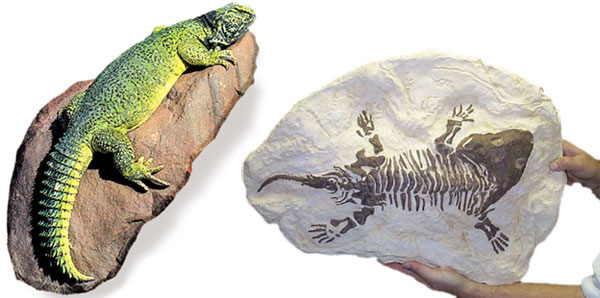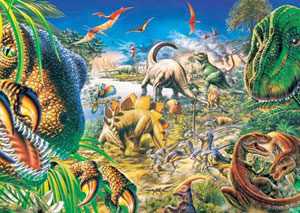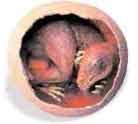Dinosaurs, lizards, turtles and crocodiles… All of these species belong to the living class called "reptiles". Some reptiles, such as dinosaurs, are extinct but some are still alive.
 |
THE SEYMOURIA MISCONCEPTION Evolutionists at one time claimed that the Seymouria fossil (left) was a transitional form between amphibians and reptiles. According to this scenario, Seymouria was "the primitive ancestor of reptiles." However, subsequent fossil discoveries showed that reptiles were living on Earth some 30 million years before Seymouria.32 In the light of this, evolutionists had to relinquish their claims regarding Seymouria. |
Reptiles have particular features, such as their bodies being covered by plate-like structures called "scales". They are cold-blooded, which means that they cannot generate their own body heat. That is why they need direct sunlight to warm up their bodies. They give birth to their young by laying eggs.
 | THE END OF DINOSAURS
Dinosaurs were the greatest land-dwelling animals that have ever lived. With their perfectly designed bodies, they lived on Earth for a long time. According to a consensus among scientists, they have become extinct because of a meteor disaster. This phenomenon was divinely planned so as to make the Earth fit for mammals and in particular human beings, which were created subsequently (according to geological records). |
Evolutionists cannot explain how reptiles came into being. The conventional evolutionist allegation on this issue is that reptiles evolved from amphibians. However, there is not a single scrap of evidence to prove this. On the contrary, an examination of amphibians and reptiles demonstrates that there are very great physiological differences between these two living groups and that a half-reptile/half-amphibian has no chances of survival.
 |
TURTLES ARE ALWAYS THE SAME There is no difference between the ancient fossil reptiles and their counterparts today. The 100 million-year-old sea turtle on the left is exactly the same as its modern counterpart. |
Accordingly, such a creature does not exist in the fossil record. Renowned evolutionist paleontologist, Lewis L. Carroll, admits this fact in his article titled "The Problem of the Origin of Reptiles":
Unfortunately not a single specimen of an appropriate reptilian ancestor is known prior to the appearance of true reptiles. The absence of such ancestral forms leaves many problems of the amphibian-reptilian transition unanswered.31
 | THE DIFFERENCE IN THE EGGS
One of the contradictions of the amphibian-reptile evolutionary scenario is the structure of the eggs. Amphibian eggs, which develop in water, have a jelly-like structure and a permeable membrane. Reptile eggs, however, have a solid and water-proof structure adapted to land conditions, as we see in the dinosaur egg reconstruction here. In order for an amphibian to become "reptilian", its eggs must turn into reptile eggs. Yet this is impossible. |
Moreover, there are also insurmountable boundaries between reptile species such as reptiles, dinosaurs or lizards. All of these distinct species arose suddenly and distinctly on the Earth, because God so created them. This fact is thus stated in the Qur'an:
God created every animal from water. Some of them go on their bellies, some of them on two legs, and some on four. God creates whatever He wills. God has power over all things.
(Surat an-Nur: 45)
31) Robert L. Carroll, Vertebrate Paleontology and Evolution, New York: W. H. Freeman and Co., 1988, S. 198
32) Die ltesten Seymouria Fossilien gehren zur Alt Permiyen Erdschicht, diese sind nmlich 280 Millionen Jahre alt. Die als die ltesten Reptilienarten angesehenen Hylonomus und Paleothyris wurden in den altpennsilvanischen Erdschichten gefunden. Diese Erdschichten sind 330-315 Millionen Jahre alt. (Barbara J. Stahl, Vertebrate History: Problems in Evolution, Dover, 1985. S. 238-39)